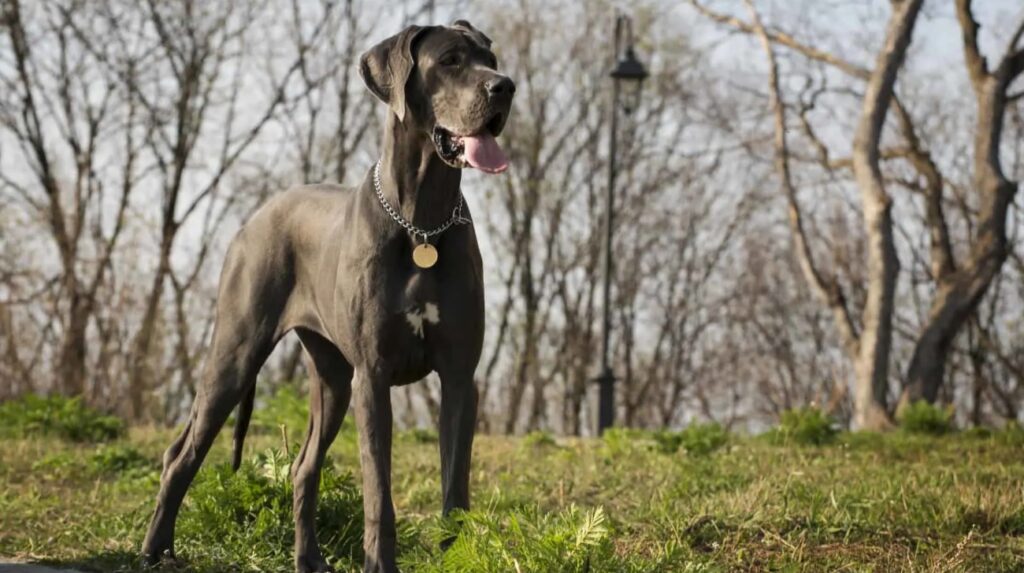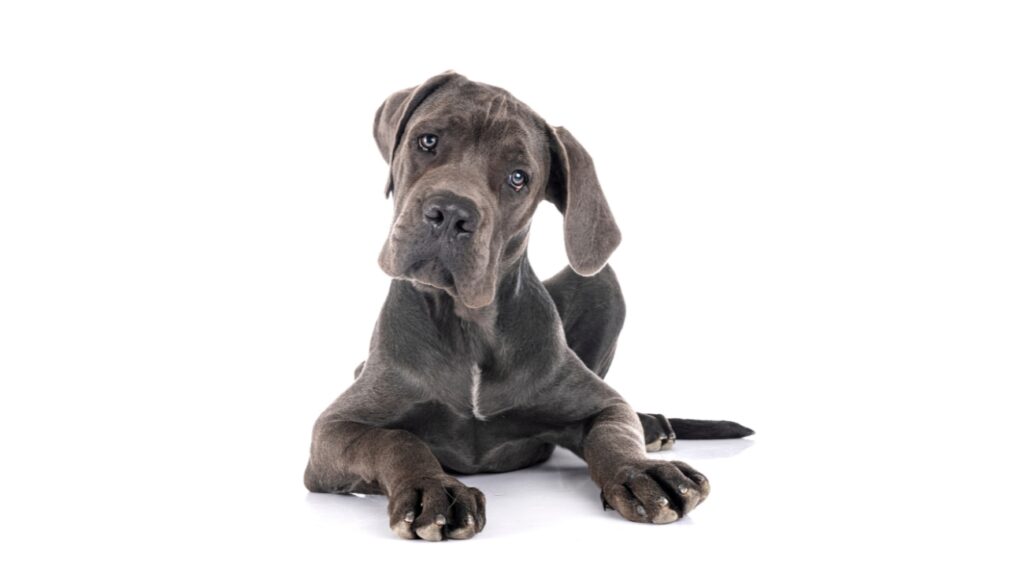Bringing a Great Dane puppy into your home is an exciting experience, but it requires careful preparation to ensure a smooth transition for both you and your new furry friend. This comprehensive guide will help you prepare your home, gather essential supplies, and create an environment that fosters your puppy’s growth and development. So, how to prepare for a Great Dane Puppy? You should know where a collar should sit on a dog’s neck for the perfect fit and comfort.
Blog Highlights
ToggleHow to Prepare for a Great Dane Puppy | Step-By-Step
So, how to prepare for a Great Dane Puppy? Preparing for a Great Dane puppy involves careful planning to ensure a smooth transition and a safe, welcoming environment. From puppy-proofing your home to gathering essential supplies and setting routines, this step-by-step guide covers all you need to know.

1. Puppy-Proof Your Home
Before your Great Dane puppy arrives, it’s important to make your home safe. Due to their size and curious nature, Great Dane puppies can easily reach countertops and knock over objects. To puppy-proof your home:
- Remove Hazards: Store cleaning supplies, medications, breakable items, and other potential dangers out of reach. Secure electrical cords and block access to hazardous areas like the kitchen or bathroom.
- Limit Access: Use baby gates to restrict access to specific rooms until your puppy is well-trained. This helps to manage their exploration and prevent accidents.
- Secure Your Yard: Although Great Danes are not typically jumpers, ensure your yard is secure with a fence at least six feet high to prevent them from wandering off.
Properly puppy-proofing your home will prevent injuries and accidents, making your home a safe environment for your Great Dane puppy to explore and grow. Find out the best e-collar for large dogs to keep your big dog safe and well-trained.
2. Setting Up a Safe Space
Creating a designated safe space for your Great Dane puppy is crucial for their comfort and security. Here’s how to set it up:
- Choose a Quiet Location: Select a low-traffic area in your home where your puppy can relax without too much noise or foot traffic. This will help them feel secure, especially during their first few days.
- Provide a Comfortable Bed: Invest in an orthopedic bed that supports your puppy’s growing body. A high-quality bed will help your Great Dane sleep better and support their overall health.
- Include Toys and Chews: Offer a variety of toys and chews to keep your puppy entertained and mentally stimulated. This can help with teething and reduce destructive chewing.
3. Preparing for Feeding
Great Danes have specific dietary needs due to their size and growth rate. Proper nutrition is critical to their development, so setting up feeding and water stations correctly is essential.
- Select Appropriate Bowls: Use sturdy, non-tip bowls for food and water. Consider raised feeding stations to reduce strain on their neck and joints while eating.
- Establish a Feeding Schedule: Feed your Great Dane puppy three to four small meals per day until they are around four to six months old. This routine helps prevent digestive issues like bloating, which can be a common concern for Great Danes.
- Gradual Food Transition: If you plan to switch from the food provided by the breeder, do it gradually over a week to prevent stomach upset. Want to know if barking collars are effective? Get the facts and decide what’s best for your dog.
4. Crate Training
Crate training is a valuable tool for managing your Great Dane’s behavior and providing them with a secure place to rest.
- Choose the Right Crate: A large, sturdy crate is essential due to the Great Dane’s size. Opt for a crate that will accommodate your puppy as they grow. A crate with expansion sections can be a good investment to avoid purchasing multiple crates as your puppy grows.
- Make the Crate Comfortable: Add a soft bed or blanket and a few toys to make the crate inviting. The crate should be a positive space, not a punishment.
Crate training can help prevent destructive behavior and accidents when you’re not around, and it provides a safe space for your puppy to relax. Want to know if shock collars hurt dogs? Learn the truth to make a safe choice for your pet.
5. Socialization and Training
Early socialization and training are essential for raising a well-behaved Great Dane. Positive reinforcement methods work best with this breed, which is eager to please.

- Start Training Early: Begin with basic commands like sit, stay, and come. Use treats and praise to reinforce good behavior. Training should be consistent, short, and fun to maintain your puppy’s interest.
- Enroll in Puppy Classes: These classes provide structured learning and socialization opportunities, helping your puppy become accustomed to new people, animals, and environments.
- Gradual Socialization: Introduce your puppy to new experiences gradually to prevent fearfulness and anxiety. Supervise all interactions with unfamiliar people and animals to ensure safety.
6. Health Care Essentials
Regular veterinary care is crucial for monitoring your Great Dane puppy’s growth and development. This includes vaccinations, parasite prevention, and regular check-ups.
- Vaccinations and Preventive Care: Work with your veterinarian to create a vaccination schedule tailored to your puppy’s needs. Vaccinations protect against serious diseases such as distemper, parvovirus, and rabies.
- Monitor for Health Issues: Be aware of common signs of illness, such as lethargy, loss of appetite, vomiting, or diarrhea. Contact your veterinarian immediately if you notice any unusual symptoms.
- Grooming: Regular grooming, such as brushing, ear cleaning, nail trimming, and bathing, is essential for maintaining your Great Dane’s health. Use a soft-bristled brush to remove loose hair and distribute natural oils. You can find the best options in 2024 that are eco-friendly and effective.
7. Exercise and Mental Stimulation
Great Danes need regular exercise and mental stimulation to stay healthy and happy. While they do not require as much physical activity as some smaller breeds, daily exercise is still important.
- Daily Walks: Aim for at least two to three 30-minute walks per day. Walking provides physical exercise and mental stimulation, which are crucial for preventing boredom and anxiety.
- Playtime and Toys: Provide interactive toys and engage in playtime to keep your Great Dane mentally stimulated. Chew toys, puzzle toys, and fetch games can be particularly beneficial.
8. Prepare for Potty Training
Potty training is one of the first challenges you’ll face with your new Great Dane puppy. Here’s how to make it easier:
- Designate a Potty Area: Consistently take your puppy to the same outdoor spot to do their business. This helps them associate the area with going potty.
- Positive Reinforcement: Reward your puppy immediately after they go potty in the right place with praise and treats to encourage repetition of the behavior.
- Be Patient and Consistent: Accidents are part of the process, especially in the early days. Focus on rewarding the desired behavior rather than scolding for accidents. Find the best dog collars for sensitive skin to keep your pup comfortable and irritation-free.
How to Put a Collar on a Great Dane Puppy: Step-by-Step Guide
Putting a collar on your Great Dane puppy is a simple but essential task to ensure their safety and begin their training. Here’s a step-by-step guide to help you properly and comfortably place a collar on your Great Dane puppy.

Step 1: Choose the Right Collar
Start by selecting an appropriate collar for your Great Dane puppy. Look for an adjustable, lightweight, and soft collar that is specifically designed for puppies. Avoid heavy or thick collars that could be uncomfortable or restrictive for your puppy’s neck. Ideally, choose a collar that will allow your Great Dane to grow into it, as they will grow quickly.

Step 2: Introduce the Collar Gradually
Before putting the collar on your puppy, allow them to sniff and inspect it. Hold the collar near their nose and let them get used to its presence. This will help reduce anxiety and make the process smoother. You can even rub the collar with your hands or give them a treat while they sniff it, creating a positive association. Ever wondered what a red collar on a dog means? Find out the meaning behind this distinctive color.
Step 3: Adjust the Collar to the Right Size
Adjust the collar size before attempting to put it on your Great Dane puppy. The collar should be loose enough to fit two fingers comfortably between the collar and your puppy’s neck but not so loose that it can slip over their head. Most collars come with adjustable straps or buckles that allow you to customize the fit to your puppy’s size.
Step 4: Calm Your Puppy
Find a quiet, calm environment to put the collar on your Great Dane puppy. Sit or kneel at your puppy’s level and gently pet them to keep them calm and relaxed. Use a calm, soothing voice to reassure your puppy during this process. If your puppy seems overly excited or anxious, take a moment to let them relax before proceeding.
Step 5: Slip the Collar Over the Head
Carefully slip the collar over your puppy’s head. Make sure to avoid pulling or forcing the collar, as this could create discomfort or anxiety. If the collar has a buckle, open it before placing it around their neck, then gently close it once the collar is in place. Ensure that the collar is not twisted and lays flat against their neck.
Step 6: Check the Fit
After the collar is on, check the fit by sliding two fingers between the collar and your puppy’s neck. The collar should feel snug but not too tight. If the collar is too loose, your puppy might slip out; if it is too tight, it could cause discomfort or breathing issues. Adjust the fit as necessary to ensure your puppy is comfortable.
Step 7: Observe Your Puppy’s Reaction
Observe your puppy’s reaction to the collar. It’s normal for them to scratch at it or seem uncomfortable initially. Distract them with treats, toys, or playtime to help them forget about the collar. Most puppies will get used to wearing a collar after a few hours or days.

Reward your puppy with praise, treats, or affection for accepting the collar. Positive reinforcement will encourage them to associate wearing a collar with positive experiences. Continue to reward them periodically as they adjust to wearing it regularly. You should know the best methods how to remove saliva stains from white dog fur and keep your pup looking pristine.
Step 8: Monitor and Adjust
Regularly check the collar’s fit as your Great Dane puppy grows. Puppies grow quickly, and their collars will need adjusting frequently to accommodate their size. Ensure the collar remains comfortable and appropriately fitted to prevent any discomfort or skin irritation.
Once your puppy is accustomed to the collar, attach an ID tag with your contact information. This is crucial for safety in case your puppy ever gets lost. Additionally, you can start using the collar to introduce basic leash training, helping your puppy get used to being led gently.
Final Words
By following these steps, you can ensure that your Great Dane puppy gets comfortable with wearing a collar, setting the foundation for proper training and safety. Remember to be patient and use positive reinforcement throughout the process. Hope so, now you know how to prepare for a Great Dane Puppy? Discover the best shock collar for large dogs with thick fur to ensure effective training with maximum comfort for your furry companion.





